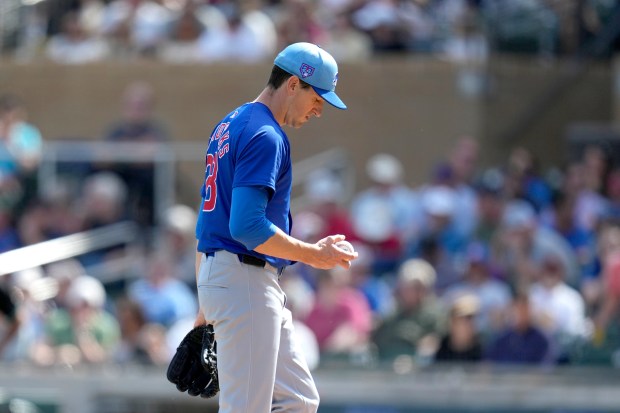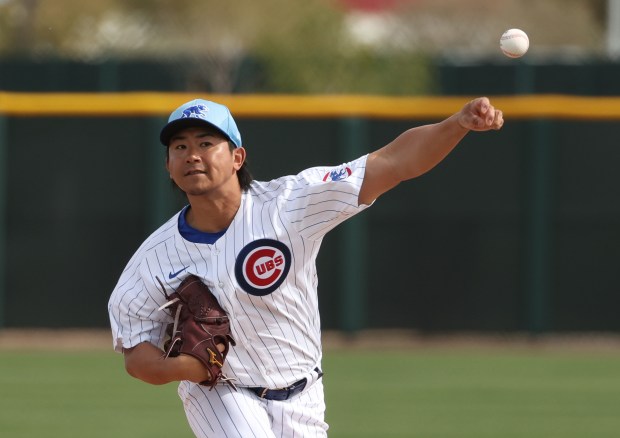MESA, Ariz. — Pete Crow-Armstrong’s time will come in the Chicago Cubs outfield.
The organization’s top prospect got his first taste of the majors in September and entered big-league camp with a chance to make the opening-day roster. However, that calculus changed when the Cubs re-signed Cody Bellinger, making Crow-Armstrong among the initial big-league camp cuts Friday.
“When we signed Cody, our thought right now is that the best place is for PCA to start in the minor leagues and start his season that way and then just knock down the door for us and make us figure something else out on the major-league side,” manager Craig Counsell said. “Signing Cody, it made sense to go that direction. … I don’t think he’s surprised, but I think he’s disappointed.”
The Cubs trimmed their big-league camp roster to 50 players with Friday’s moves. Crow-Armstrong, right-hander Ben Brown, infielder Luis Vázquez and outfielder Brennen Davis were optioned to Triple-A Iowa while right-handers Michael Arias and Porter Hodge and outfielder Kevin Alcántara were optioned to Double-A Tennessee. Five nonroster invitees have been reassigned to minor-league camp: outfielder Owen Caissie, infielder Matt Shaw, catcher Pablo Aliendo and right-handers Ethan Roberts and Riley Thompson.
Crow-Armstrong, Brown, Caissie and Shaw all gained value experience this spring being surrounded by big-leaguers and gave the coaching staff a reason to keep eyes on them in the minors. They’re part of a Cubs system that boasts a lot of depth to complement their high-ceiling top-prospect talent.
“They’re four talented players and they’re going to be Chicago Cubs in the future,” Counsell said. “They’re important to the organization. … The best thing to have is numbers to me because guys are going to surprise you and we’re going to be disappointed by some players, but there’s a lot of them, and that’s the best thing.”
Brown was on the verge of helping the Cubs out of the bullpen late in the season when an injury sidelined him. He is already on Counsell’s radar after showing quality stuff this spring. As for whether a promotion to the bullpen versus the rotation initially to get experience could be Brown’s best path to the majors, Counsell doesn’t view it that way.
“I like pitchers that get outs, and I don’t mean to kind of be flippant about it, but when you get called up to the big leagues in the place that the Chicago Cubs are in, we’re looking for people to get outs,” Counsell said. “I don’t think we have to stick to roles. Outs are more important than roles. Do we consider what role a pitcher is accustomed to and how he might best have success? Yeah, absolutely, that matters. So we have to consider that for sure. Getting outs at the big-league level is a hard thing to do.”
Shota Imanaga shows the good and bad with his fastball
The left-hander isn’t quite ready to unleash his full arsenal two starts into his spring schedule.
Imanaga allowed two runs on four hits, including a home run, in three innings Friday against the Seattle Mariners. He wanted to throw his fastball up in the zone for strikes but misfired a couple, one of which landed over the outfield wall.
“It was the same issue I had last time,” Imanaga said through interpreter Edwin Stanberry. “So just continue to work on that and make adjustments. … I’ve been throwing those fastballs to try to get ahead, get strikes, and I’ve been missing it a little bit.”
As Imanaga continues to work on commanding his fastball, he is quickly learning that big-leaguers can feast on that pitch. His five strikeouts Friday show how nasty the pitch can be, too, especially when working off his secondary stuff, which will become much more important during the regular season to keep hitters off his heater.
“Players, even like the little smaller players, they have a lot of power and then the pitches that I miss my location, instead of being like a single, they can hit it up,” Imanaga said.
Kyle Hendricks focuses on his curveball

Cactus League games are an ideal environment for pitchers to hone their repertoire, even for veterans such as Hendricks.
Getting a better feel for his curveball has been a focal point for Hendricks. It accounted for only 3% of his pitches thrown last season, but he knows he needs another secondary pitch in starts when his typical fastball-changeup combination isn’t as effective. During Friday’s start against the Diamondbacks, he threw 15 curveballs to only two changeups, the latter of which he threw to Geraldo Perdomo, who led off the fourth and was the final batter he faced.
“Honestly, I was pretty happy with it,” Hendricks said of his curve. “(Catcher Miguel Amaya) and (Mike Tauchman) out in center said it’s not popping out of my hand. I’m getting some good reactions just from the hitters, so it’s good to see and it’s going to breed confidence in me the more I throw it.”



